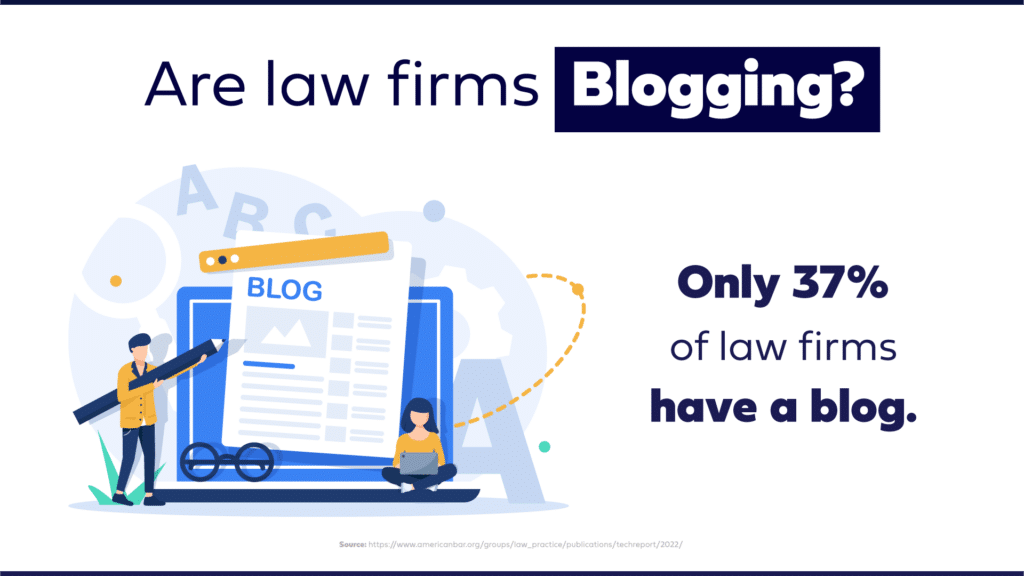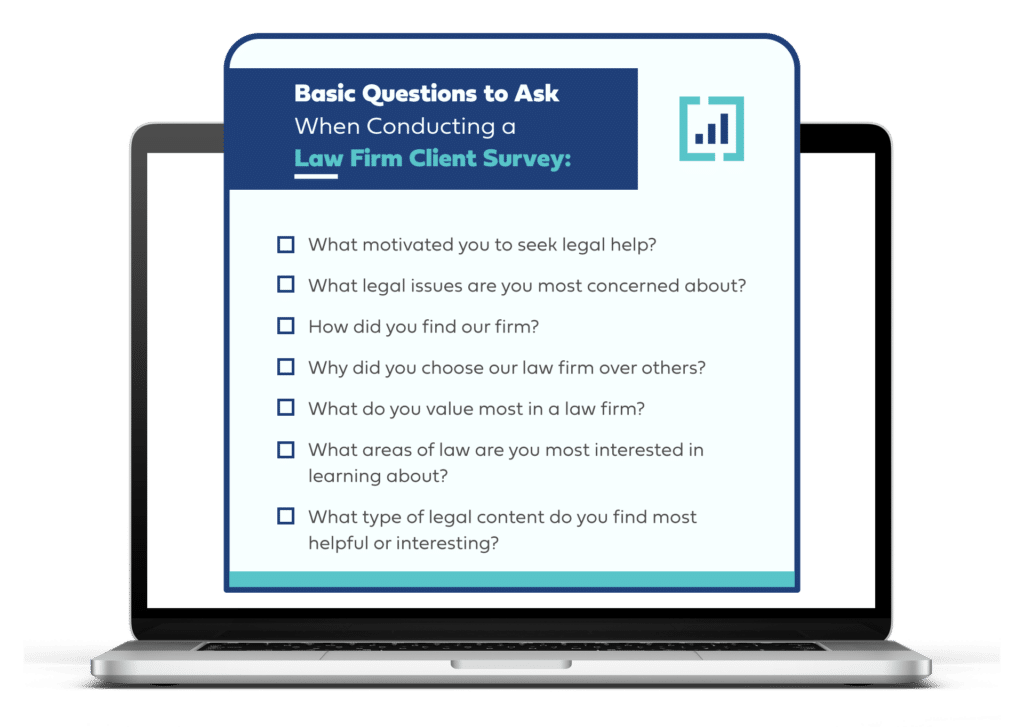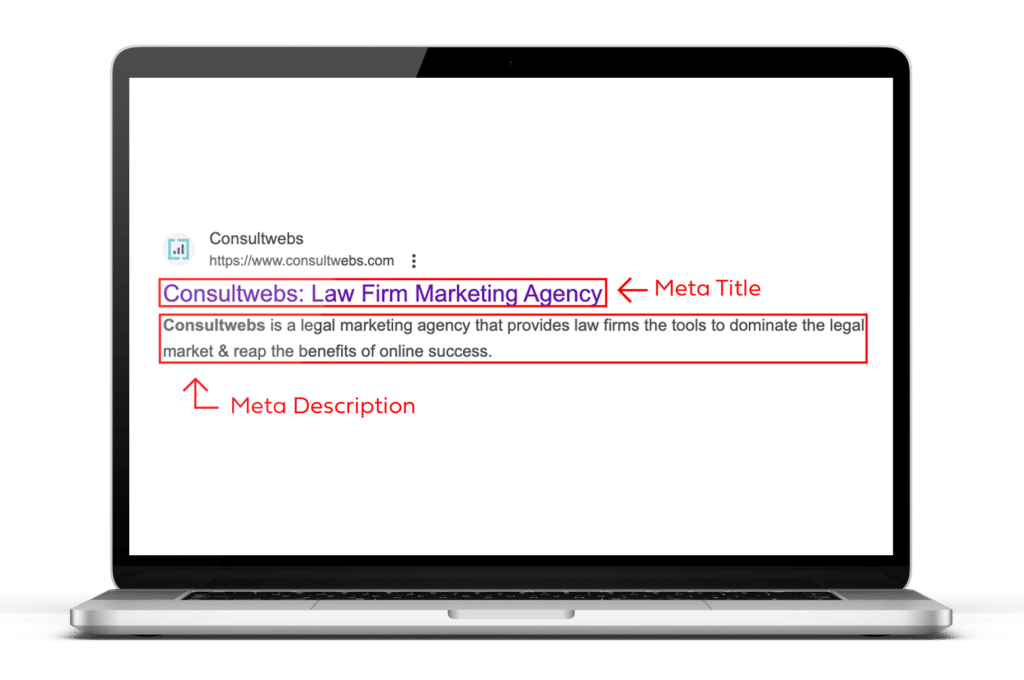A Comprehensive Guide to Law Firm Blogging
Blogging for lawyers is a vital strategy that unlocks opportunities for law firms to demonstrate their expertise, engage with their audience, and elevate their online visibility. Discover how a well-strategized, SEO-driven, customer-centric blog can become your law firm’s hidden goldmine.
According to statistics, Internet users in the US spend 3X more time on blogs than they do on email. And, are law firms keeping up? Surprisingly, the recent ABA tech report found the following:
More than half of law firms are still operating at a snail’s pace when it comes to nurturing their blogs. But what if I told you that a well-crafted, regularly updated blog could be your secret weapon to outshine competitors?
While it’s true, every law firm is vying for attention. There are small details that can make all the difference, which is when a blog isn’t just an optional add-on. It’s an essential tool to improve your blog strategy for Law firm SEO and ultimately draw clients and prospects back to you.
How to Create an SEO Blogging Strategy for Your Law Firm
Think of blogs as your firm’s digital backbone and an extension of your firm’s online personality.
Blogging has evolved from a personal pastime to an increasingly professional strategy. Although blogs originally started with individuals sharing insights into their lives, they have become a key part of a business’s growth strategy.
Here are just some of the benefits of keeping a legal blog on your site can bring you:
- Drive traffic (and convert traffic into quality leads).
- Strengthen your social media strategy.
- Impact long-term success.
- Link you and other platforms.
- Give you a space to voice opinions/ideas/news.
Our favorite benefit is that strategically planned blog posts and topics can also help your site rank higher on the SERP. How?
Think about it, if you’re maintaining your blog updated, your firm’s site is constantly receiving additional content. This informs search engines like Google that your firm’s website is active and that it has valuable and relevant information that answers users’ questions.
Your blog has to cater first to readers and then to the search engines in order for it to rank. Because of this, the first step is making sure the content is relevant to your audience. The second step is optimizing your content with some SEO best practices. Stay with us as we unfold SEO practices you can incorporate in your firm’s blog section.
Start By Creating A List of Topics

When you first stare at a blank piece of paper, you might be completely confused about where to start. What should you write about? What shouldn’t you write about? Don’t stress it too much! Go ahead and brain-dump all of the different topics you feel comfortable writing about.
A good point to start is by asking yourself questions like:
- What are the points of difference that make your law firm unique?
- What are your firm’s specializations?
- What are trending topics within your practice area?
- Are there news and updates your clients should be aware of?
Coming up with questions like this can help you get the creative juices flowing. It can help to think of what your law firm does and what it can offer for its clients and readers. Besides the aforementioned questions, you might also add topics, i.e., within family law, about surviving divorce, starting over, taking care of yourself during this time, and much more.
It is important that your firm thinks of the bigger picture in terms of blog posts. Remember, your clients are looking at your services, but beyond that, they need you to take the role of the fixer and the problem solver. So your clients would appreciate you going the extra mile and providing them with external sources of information.
Creating Effective Personas: Tailor Your Law Firm’s Blog Content for Target Audiences
Ever heard the saying, “The customer is king”? In the world of blogging, we say, “The reader is king.”
Often, you might hear marketers stress the importance of understanding your audience, but how do you understand your audience, and more so, how do you apply that to your content strategy?
By following these actionable steps, you can create accurate and effective personas that will help guide your blogging strategy:
- Define the Basics: Start by defining the basics of your persona, including demographics such as age, gender, occupation, and income level.
- Identify Legal Needs: Outline the typical legal needs and concerns your persona might have. Are they dealing with a personal injury case? Maybe they’re in the middle of a complicated divorce. Or perhaps they’re seeking legal advice for their small business?
- Understand their Motivations: Dig deeper to understand what motivates them to seek legal help. What are their fears, challenges, or pain points that would prompt them to seek your services?
- Follow the Funnel: Your personas are at different stages, and that is okay! Keep in mind that a new visitor might just be looking for basic legal information (top of the funnel), while a return visitor might be comparing your firm with others (middle of the funnel), and a long-time client might be ready for a deeper engagement (bottom of the funnel).
- Conduct Client Surveys: Once you’ve closed a case, there is a great opportunity in your hands to follow through with a survey and ask questions like:
- Analyze Your Interactions: Do you have a strategy in place for effective legal intake management? Part of improving is taking a few steps back and analyzing how your interactions with prospects and clients went. This may include any consultations, communications, e.g., emails, and checking for any recurring patterns or common questions that you’re being asked.
Research the keywords

Keywords can give you a jumpstart with your content writing.
You can plan content around keywords that are relevant in the legal industry. An example of a tool you can use to find out what keywords are trending is Google’s keyword planner. No matter which platform you pick, keyword research is a must.
After finding the right keywords, you can get additional information such as word difficulty, ranking, cost-per-click, bidding price, and overall volume. Your firm can also find the “SEO difficulty,” also known as keyword competition. It will help discover how your keyword(s) rank on Google’s organic search results page.
Your firm can also implement long-tail keywords. These are long, specific keywords. They are easier to rank and highly targeted.
Once you find a set of keywords to use, you can add keywords in the following blog sections:
- Blog post headline.
- Blog post headings.
- Introduction and body of the post.
- Conclusion of the blog post (helps re-emphasize).
Additionally, it is imperative to think of the user intent:
- Navigational intent – The user is looking for a specific page.
- Informational intent – The user is looking for information.
- Transactional intent – User wants to purchase your service.
This background information can help you speak directly to your prospects by addressing their needs and capturing their attention in their search journey.
And what about keyword usage for blogging? Here are some of the best tips:
- Keyword Research: The first step is to identify relevant keywords. Tools like Google Keyword Planner, SEMrush, and Ahrefs can help you find keywords that your potential clients are using to search for legal services. Short-tail keywords, e.g., law firm, may be too broad, generic, and quite expensive. Instead, focus on long-tail keywords (phrases with three or more words) that are specific to your practice areas.
- Use Keywords Naturally: Google prioritizes content that reads smoothly, so avoid ‘keyword stuffing’. Your keywords should fit seamlessly into your sentences.
- Optimize Images: If you use images in your blog posts, ensure that you include keywords in the file name and the image alt text.
Focus on Quality, Not Quantity
Numbers can be impressive, but in the world of Law firm SEO, quality trumps quantity every single time, and the biggest search engine, Google, agrees!
In December 2022, Google updated its Quality Rater Guidelines to EEAT, which stands for Experience, Expertise, Authoritativeness, and Trustworthiness. The EEAT acronym, updated in December 2022, reflects the principles Google values in assessing content:
- Experience assesses the content creator’s firsthand knowledge of a subject. For law firms, it’s about the writer’s practical experience in the discussed legal area.
- Expertise pertains to the creator’s knowledge, skills, and qualifications.
- Authoritativeness measures a website’s credibility. Law firms can build this by publishing top-notch content, thus establishing a reputable industry presence.
- Trustworthiness emphasizes the reliability of content, underscored by accurate citations, transparent sourcing, and a commitment to accuracy and impartiality.
How can you start? We’ll give you 4 tips:
- Develop Deep-Dive Content: Instead of covering a wide range of topics in a superficial manner, select specific topics and delve deep. What is unique in your firm’s practice area?
- Harness the Power of Storytelling: Law firm storytelling is perhaps one of the most powerful yet underrated tools for engagement and relatability. Start by incorporating real-world cases, anecdotes, or hypothetical scenarios to explain complex legal concepts.
- Validate with Reliable Sources: Always cite reliable and reputable sources to improve transparency and add credibility to your assertions.
- Employ a Content Specialist: While these are all helpful tips, the best law firms can do today is delegate and hire legal content specialists to focus on more pressing legal matters — your client’s case.
One of Google’s top-ranking factors is content quality.
You can also learn how to compile a “power page” to grow your firm. Your firm’s content production should be top-notch. To ensure this, you need to offer relevant, new insights and solutions.
There are several reasons you need to keep your content up-to-date, but an indispensable reason is to increase your firm’s number of pages in Google’s index. This improves your firm’s website and strengthens your firm’s domain.
Besides quality, your blog should also remain consistent. Search engines feed off fresh content. By pushing quality content, you are signaling Google’s search engine that your content is helping the user.
As for how often you should post, there is no correct formula for this. But, as a rule of thumb, you should “maintain quantity without sacrificing quality.” Therefore, experiment with posting, i.e., once a week or once a month, and see what works specifically for your firm.
Write for humans first

One of the biggest challenges in SEO for blogs is making sure the content ranks with search engines and appeals to the users. If you find yourself at a crossroads, the best practice here is to write for humans first.
With that said, your firm’s blog strategy should have the following purposes in mind:
- Inform the reader of your firm’s services and solve a problem.
- Offer appealing information for the reader (answer questions, give them new relevant information, current legal matters they should know about, etc.)
- Drive new traffic.
You can then go in-depth into what the purpose of the blog will be:
- Will the purpose be to educate? Inform?
- Why do your clients need this blog section?
- What are you trying to enhance with your blog posts?
- What actions do you expect the reader to take?
- How will the readers benefit from the information you post?
These are questions you should ask yourself beforehand. They will give your firm’s blog section a direction when coming up with topic ideas.
Make Sure To Speak Your Audience’s Language

When you are coming up with a brainstorming list, really think about what your audience is searching online for. Some of the top questions law firm clients are searching for are:
- What is your firm’s specialization?
- How much money am I able to win within a settlement?
- What are your firm’s fee policies?
Your potential clients may be looking for information on how to find the right lawyer and what they can do to protect themselves during their time of need. They might also be pondering whether they really need a lawyer, and they will typically turn to Google to find the answer. For this reason, it is vital that your firm comes across as friendly and one that is ready to help and educate its clients and prospects.
Having said this, when you are meeting with new clients, take the time to listen to their concerns and see if that is something that you can blog about. You can also do polls in your office or on your website or social accounts to interact with your clients to see what topics are important to them. Don’t be afraid to ask your readers to let you know if there is something that they would want to read more about. All of these topics can be added to your list.
Craft the Structure that Works
There are many best practices when it comes to the structure of your blog post. But the following are the basic foundations to improve rankings:
- Headline: Headline tips your firm can follow include mixing the keywords and writing several headline options to test out. The title should be in an H1 tag and have a character length between 20-70.
- Paragraphs: Keep the paragraphs short and simple. You can cut them out into smaller sections or add lists or bullet points. Furthermore, add bold, Italic, and/or underline to emphasize specific points.
- Link building: Legal link building has proven to boost rankings. In short, it gives search engines like Google the signal that you’ve done the research and provided quality and new information.
- Meta Title: The meta title needs to describe your page using 56-62 characters. It is important to keep the keywords you want to rank for at the beginning of the title.
- Meta description: This description should be 150 – 156 characters and usually appears like the following image in Google:
How long should a law firm blog post be for SEO purposes?’
As a whole, the law firm blog posts that perform better on SERP (search engine results pages) like Google tend to be long-form blog posts – like this one!
While many businesses tend to stick to short-form copies of around ≈500 words, the reality is that the content should answer the main question, and sometimes that means adding an elaborate explanation. Research states that certain blogs looking to build authority should aim for 1,000-1,500 words, and when writing guides and how-to blogs, the content should be around 1,500-2,500 words.
We live in a digital age. Nowadays, most people turn to their friends, family, Facebook, and other platforms like Google to learn about something new. You may be wondering what that means for you and your law firm, and the truth is that, if you want to continue to grow your business, you need to be online. You need to have a blog that will pull in potential customers when they are googling for information.
One way to pull prospects into your firm’s website and keep them engaged is through the creation of blog posts. Blog posts help engage different types of users and might even help your firm convert this traffic into leads.
Though you may not be a big writer, it is possible to write your own blog and consequently bring in more customers through continuous engagement. Although this type of content creation is vital, getting started may be challenging. Here are some tips to help your firm get started:
Create the Perfect Publishing Schedule

Now that you have a list, it is time to sit down and figure out how often you should schedule your blogs. In the beginning, it is more important that you schedule blogs regularly so if you are only able to write once a month, that is a fine place to start. Then, as you get more comfortable, you may be able to increase it to twice a month or even weekly. If you have multiple partners and multiple areas of expertise, you may be able to blog even more than that!
It may surprise you that when your blog is even more important than how often you blog. For this reason, it’s best if your firm publishes at the same time so clients know when to expect more content from you.
When brainstorming the blog’s frequency you can start small and post small content once a week or once every two weeks etc. This is relative information that your firm can scale down or up. Nevertheless, it’s in your firm’s best interest to keep consistency when a blog post is launched.
Consistency is Key When Publishing!

Now that you have plenty of topics and have a calendar set up, it is time to actually start writing! Most people find it helpful to set aside time every month to work on their blog. You may want to carve out half of a day once a month to devote to your blog, or it may be easier to find an hour or two every week to spend writing. You will have to find out what works best for you.
Your consistency should match your answer in regards to, “How often do you want to post a blog?” If you decide you’ll want to publish once a week, then it is important you set some weekly time beforehand to brainstorm and work your way through writing the blog post.
Above all, consistency will always win.
Go The Extra Mile in Case of Emergencies

That being said, just because you have time set aside for writing, doesn’t mean that you will actually have scheduled spurts of divine inspiration. Writer’s block is a serious problem, and it isn’t just for writers. Anyone who has to produce a piece of writing can struggle to get the words written down.
So, what can you do? It is always a good idea to have a few spare blogs that you can publish when you are struggling to come up with an idea or write a blog. Then, hopefully, your next writing session will go over better!
Before you even start your blog, you should take the time to brainstorm for ideas. Make some broad ideas and some that are more targeted to certain clients. You should continuously add to this list, so you have a base of ideas to come back to. Adding to this, always keep your audience in mind. At the end of the day, the blog posts are intended for them. Therefore, make sure you’re bringing something to the table (and someone to your door).
Most bloggers recommend setting aside certain times every month to work on your blog. You may want to write a month’s worth of blog posts at a time, or you may want to spend an hour or two a week on that week’s blog. This depends on your creative flow, time, and disposition.
Team Up With Qualified Writers and Editors

If you are struggling to get your blogs written, don’t fret. You might be better off hiring someone to write them for you. You can guarantee a well-written blog every week (or whatever schedule you decide on), without worrying about the pains of planning and writing.
Above all, don’t waste opportunities to educate your clients and prospects. Go the extra mile.
Are you ready to wow your website’s visitors with information-packed blogs? Discover how Consultwebs can help you up your content game.







